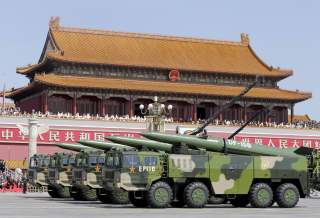Did Ukraine Give China an Unstoppable Nuclear Missile Arsenal?
A surprising duo...
Key Point: Ukraine renounced nuclear weapons, but it still had plenty of know-how and delivery systems to give.
While Ukraine renounced its own possession of nuclear weapons in 1994, many scientists and design bureaus in the country still have the know-how required to manufacture important components of strategic weapons. China has often been particularly keen of this knowledge, acquiring Ukrainian help in designing their first phased-array radar system. Chinese poaching of Ukrainian aerospace, tank and naval engineers is also a common phenomenon, most notably Valerii Babich, designer of the Varyag aircraft carrier. There are even rumors of “Ukrainetowns” in some Chinese cities founded by the large number of expats hired by Chinese firms. Ukrainian and Russian businessmen even sold Kh-55 nuclear cruise missiles (without the warheads) from Ukrainian stockpiles to China in the 2000s. As China continues to modernize their ICBM fleet, it begs the question: how much help is Ukraine providing, willingly and unwillingly?
This wouldn’t be the first time Ukraine’s ICBM knowhow was possibly exported. In the fall of 2017, Ukraine’s Yuzhnoye Design Bureau, based in Dnipro, was accused of providing rocket engines to North Korea. While Ukrainian media has denied this allegation, there was a definite case of Yushnoye employees who were caught selling the plans on the RS-20 (SS-18 “Satan”) to Chinese missile engineers. Although the Chinese engineers were caught by Ukrainian police, Chinese diplomatic influence resulted in the charges being cleared. This trend has continued, as recently as 2016 when a scientist at Dnipropetrovsk National University left for China with many materials regarding the use of composites and heat-shielding coatings on rocket launchers—which were considered Ukrainian state secrets.
China’s interest in the RS-20 was at least partially borne out of its desire to field MIRVs on their ICBMs. This has begun with the deployment of the DF-5B ICBM and looks to continue with the deployment of the DF-41 ICBM. Whether the MIRV designs on the DF-5B were derived from “acquired” Ukrainian RS-20 plans is uncertain, but possible due to the similar diameters of the DF-5 and RS-20 missiles. However, some Chinese forum users have suggested that Ukraine has provided aid in the development of the DF-5B through a different vector. The article states that Sino-Ukrainian cooperation on civil space ventures, specifically the RD-120 engine and the RD-9 attitude control engine could be used to improve the DF-5B ICBM.
However, one telling aspect that could belie significant Ukrainian aid or input into the Chinese missile program is the commonality between their recent missile systems. Sources have said that the development of the DF-4—a train-based ICBM—will speed up the development of their new JL-3 submarine launched ballistic missile (SLBM). This mirrors the commonality between the Soviet RT-23 (SS-24) train-launched ICBM and the Soviet R-39 SLBM. The first stage of the R-39 is the 3D65, a Yuzhnoye product. This same motor is also used in the RT-23, which was fully designed by Yuzhnoye.
The DF-41 is similar to the RT-23 in many aspects, both use three stages of solid-fuel motors and carry ten MIRV warheads. While China has developed common land/sea missile pairs before in the DF-31/JL-2 and the DF-21/JL-1, the JL-1 and DF-21 are two-stage designs, and the DF-31/JL-2 were originally designed for single warheads, not MIRVs—although the capability was added later. Other sources have noted the similarities between the DF-41 and the RT-23, although Russian sources deny this, citing the extended range of the DF-41 compared to the RT-23.
Given all the different vectors through which rocket and missile technology are flowing from Ukraine to China, it’s reasonable to say that Ukraine has provided considerable aid to the Chinese ballistic missile program. While the new generation of Chinese missiles may not be exact analogues of the ones Ukraine designed some decades ago, the continual flow of Ukrainian state secrets regarding missiles, the immigration of Ukrainian engineers and scientists, and the cooperation between Ukraine and China on civilian rockets all result in a situation where modern Chinese ICBMs probably incorporate Ukrainian know-how in one aspect or another.
Charlie Gao studied political and computer science at Grinnell College and is a frequent commentator on defense and national-security issues.
Image: Wikimedia Commons.

